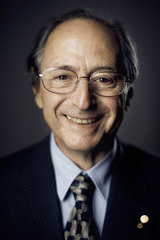Michael Levitt个人主页
Dr Michael Levitt is a Robert W. andVivian K. Cahill Professor of Cancer Research, and Professor, byCourtesy, of Computer Science at Department of Structural Biology,Stanford University. He is the Laureate for The Nobel Prize in Chemistry 2013, "for the development of multiscale models forcomplex chemical systems". Dr Michael Levitt is an Adjunct Professor of Shanghai Institute for Advanced Study of ZhejiangUniversity (SIAS).
Here is how he describe his work and the research from his lab at Stanford University:
“I pioneered of computational biology setting up the conceptual and theoretical framework for a field that I am still actively involved in at all levels. More specifically, I still write and maintain computer programs of all types including large simulation packages and molecular graphics interfaces. I have also developed a high-level of expertise in Perlscripting, as well as in the advanced use of the Office Suite ofprograms (Word, Excel and PowerPoint), which is more important and rare than it may seem. My research focuses on three different but inter-related areas of research. First, we are interested in predicting the folding of a polypeptide chain into a protein with a unique native-structure with particular emphasis on how the hydrophobic forces affect the pathway. We expect hydro phobic interactions to energetically favor structure that are more native-like. In this way, the same stabilizing interactions that exist in the final folded state the search tractable. Second we are interested in predicting protein structure from sequence without regard for the process of folding. Such prediction relies on the well-established paradigms that similar protein sequences imply similar three-dimensional structures. We have focused on the hardest problem in homology modeling: the refinement of a near-nativestructure to make it more precisely like the actual native structure of protein. We have also focused on how the general similarity of all protein sequences resulting from their evolution from common ancestorsequence affects the nature of the protein universe. Third, we are focusing on meso scale modeling of large macromolecular complexes suchas RNA polymerase and the mammalian chaperonin. In this work, done in close collaboration with experimentalists, we use new morphingstrategies combined with normal mode analysis in torsion angle spaceto overcome problems caused by the size and complexity of thesecritical, biomedically important systems. All this work depends on the way a molecular structure is represented in terms of the force-field that allows calculation of the potential energy of thesystem. We employ a very wide variety of such energy functions that extend from knowledge-based statistical potentials for a single interaction center per residue to quantum-mechanical force-fields that include inductive effects as well as polarization.”


